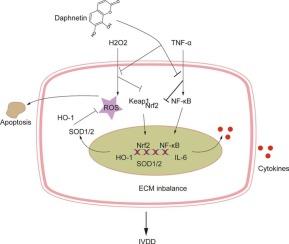在体外和体内实验中,瑞香素通过Keap1/Nrf2/NF-κB轴改善椎间盘退变。
IF 4.7
2区 医学
Q2 IMMUNOLOGY
引用次数: 0
摘要
椎间盘退变(IVDD)是导致腰背痛(LBP)的主要原因。炎症和活性氧(ROS)水平的升高会导致细胞凋亡,而细胞凋亡是 IVDD 的初始因素之一。我们之前的研究表明,萘丁(DAP)能缓解 IVDD,但其潜在机制仍不清楚。为了研究 DAP 的调节机制,我们通过腰椎间盘穿刺建立了 IVDD 小鼠模型,并腹腔注射了 DAP。此外,用肿瘤坏死因子-α(TNF-α)/H2O2挑战髓核细胞(NPC)以模拟IVDD。此外,还对 NPC 的凋亡、ROS 和促炎细胞因子的表达进行了全面评估。我们发现,DAP能逆转H2O2诱导的ROS,并通过抑制核因子-卡巴B(NF-κB)和丝裂原活化蛋白激酶(MAPK)通路发挥抗炎作用。此外,我们还发现 DAP 可抑制 H2O2/TNF-α 诱导的鼻咽癌细胞凋亡。DAP 可通过 Kelch-like ECH-associated protein 1/NF-E2-related factor 2/heme oxygenase-1 (Keap1/Nrf2/HO-1) 通路调节 ROS 生成和细胞凋亡。这些发现得到了体内结果的证实。我们研究的全面性为将 DAP 用作缓解 IVDD 的潜在治疗药物奠定了坚实的基础。本文章由计算机程序翻译,如有差异,请以英文原文为准。

Daphnetin ameliorates intervertebral disc degeneration via the Keap1/Nrf2/NF-κB axis in vitro and in vivo
Intervertebral disc degeneration (IVDD) is the primary cause of low back pain (LBP). Enhanced inflammation and reactive oxygen species (ROS) levels can cause apoptosis, which is one of the initial factors of IVDD. Our previous study showed that daphnetin (DAP) alleviates IVDD; however, the underlying mechanisms remain unknown. An IVDD mouse model was established by lumbar disc puncture to investigate the mechanisms of DAP regulation, and DAP was injected intraperitoneally. Moreover, nucleus pulposus cells (NPCs) were challenged with tumor necrosis factor-alpha (TNF-α)/H2O2 to mimic IVDD. Additionally, NPC apoptosis, ROS, and the expression of proinflammatory cytokines were comprehensively assessed. We found that DAP can reverse H2O2-induced ROS and play an anti-inflammatory role by inhibiting Nuclear factor-kappa B (NF-κB) and mitogen-activated protein kinase (MAPK) pathways. Moreover, we found that DAP inhibits the apoptosis of NPCs induced by H2O2/TNF-α. DAP may regulate ROS production and apoptosis via the Kelch-like ECH-associated protein 1/NF-E2-related factor 2/heme oxygenase-1 (Keap1/Nrf2/HO-1) pathway. These findings were confirmed by in vivo results. The comprehensive nature of our research provides a strong foundation for the potential use of DAP as a therapeutic agent to alleviate IVDD.
求助全文
通过发布文献求助,成功后即可免费获取论文全文。
去求助
来源期刊
CiteScore
8.40
自引率
3.60%
发文量
935
审稿时长
53 days
期刊介绍:
International Immunopharmacology is the primary vehicle for the publication of original research papers pertinent to the overlapping areas of immunology, pharmacology, cytokine biology, immunotherapy, immunopathology and immunotoxicology. Review articles that encompass these subjects are also welcome.
The subject material appropriate for submission includes:
• Clinical studies employing immunotherapy of any type including the use of: bacterial and chemical agents; thymic hormones, interferon, lymphokines, etc., in transplantation and diseases such as cancer, immunodeficiency, chronic infection and allergic, inflammatory or autoimmune disorders.
• Studies on the mechanisms of action of these agents for specific parameters of immune competence as well as the overall clinical state.
• Pre-clinical animal studies and in vitro studies on mechanisms of action with immunopotentiators, immunomodulators, immunoadjuvants and other pharmacological agents active on cells participating in immune or allergic responses.
• Pharmacological compounds, microbial products and toxicological agents that affect the lymphoid system, and their mechanisms of action.
• Agents that activate genes or modify transcription and translation within the immune response.
• Substances activated, generated, or released through immunologic or related pathways that are pharmacologically active.
• Production, function and regulation of cytokines and their receptors.
• Classical pharmacological studies on the effects of chemokines and bioactive factors released during immunological reactions.

 求助内容:
求助内容: 应助结果提醒方式:
应助结果提醒方式:


